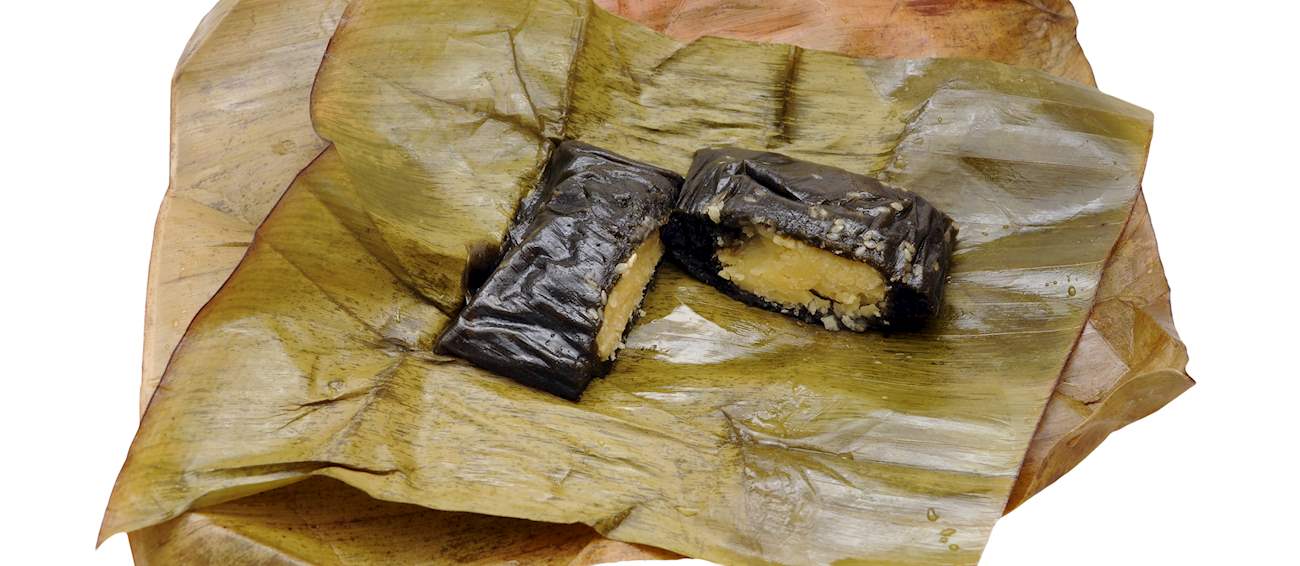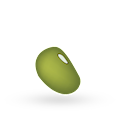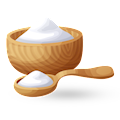MAIN INGREDIENTS
Chè đậu xanh is a traditional dessert soup. It's prepared with mung beans as the main ingredient. Apart from the mung beans, the soup also contains water, sugar, and coconut milk. The beans are soaked, drained, rinsed, then slowly simmered with sugar until tender.
Coconut milk is added near the end of cooking, and the soup is then left to cool down or chilled in the refrigerator. Due to the fact that mung beans have cooling properties, chè đậu xanh is especially popular in the summer.
Bánh gai is a Vietnamese cake consisting of dark-colored dough that is stuffed with a sweet filling. The dough combines rice flour and a paste or a powder that is made from thorn leaf (gai or ramie)—a plant belonging to the nettle family.
The filling is typically made with mung beans, shredded coconut, sesame and lotus seeds, sugar, pork fat, and flavorings, while some optional additions may also include ginger, pumpkin jam, or roasted peanuts. Before they are steamed, the cakes are wrapped in dry banana leaves.
MAIN INGREDIENTS
Chè hạt sen is a traditional sweet soup hailing from Hue. This local specialty contains buttery lotus seeds and green rice flakes in a sweet broth. Due to the cooling properties of this dish, locals often consume it in the summer in order to combat the heat.
In the past, this sweet soup was served to royal families. Nowadays, the residents of Hue serve it to important guests on special occasions.
MAIN INGREDIENTS
Chè khoai môn is a traditional taro pudding. This simple dessert is prepared with cubes of taro, sticky rice, pandan extract, and sugar. The cubes of taro are steamed until soft, then combined with cooked sticky rice, a few drops of pandan, and sugar.
This pudding is served hot or chilled, and it's recommended to top it with coconut sauce before serving.
Bánh trôi is the name of a traditional Vietnamese dessert which consists of delicious tiny balls of glutinous rice wrapped around a sweet filling. The sticky and elastic dough for bánh trôi is made with a mixture of plain and glutinous rice flour that's merely bound with water.
The dough is wrapped around a piece of dark palm sugar, rolled into a ball, and cooked until the balls float up to the surface. This authentic Vietnamese dessert is usually associated with northern Vietnam, especially the region of Hanoi. It is served freshly prepared, and roasted sesame seeds or grated coconut are sprinkled on top of each piece.
MOST ICONIC Bánh trôi
View moreChè chuối is a simple Vietnamese dessert consisting of tapioca pearls and sliced bananas or plantains, preferably small, ripe, and sweet varieties usually found in Southeast Asia. Tapioca and bananas are combined with coconut cream or coconut milk, and the dish is often sweetened and occasionally flavored with pandan leaves.
The coconut cream provides creaminess, while tapioca pearls give the dessert its typical pudding-like consistency. Chè chuối is usually served in bowls, and it's sometimes garnished with crushed peanuts or sesame seeds.
Bánh cam and bánh vòng are traditional donut-like fritters originating from Vietnam. Bánh cam is traditionally sold together with bánh vòng, and the difference lies in the fact that bánh cam is round, while bánh vòng is ring-shaped, similar to a thin donut with a hole in the middle (vòng means ring).
Both types of donuts have a caramel glaze on top, but bánh vòng doesn’t contain the mung bean filling as bánh cam does. If properly prepared, the donuts should be crispy on the outside, and soft, chewy, and dense on the inside.
This traditional Vietnamese dessert originated in Hải Dương. It combines mung beans, vegetable oil or pork fat, sugar, and flavorings to create a cake with a fudge-like consistency and a smooth texture. It is believed that the cake first appeared in the 1920s, and since then, this simple combination has earned a status of a favorite local sweet and has become well-known in the entire country.
Traditionally, pieces of bánh đậu xanh are accompanied by a cup of green or lotus tea.
Vietnamese chè dishes include any traditional sweet soup, beverage, pudding, or any other custard-like dessert that is made with a base of either water or coconut cream and served either hot or cold. Other ingredients for making chè include various jellies and fruits, beans and pulses, rice and grains, and even tubers and cereals.
It is believed that chè desserts originated in the central region of Vietnam, but today they are widely available throughout the country and prepared in countless variations. Because of their hearty contents like beans and sticky rice, they are a popular snack item commonly sold in plastic cups at Vietnamese grocery stores, while one of the most popular chè varieties prepared at home is the so-called chè đậu trắng.
VARIATIONS OF Chè
MOST ICONIC Chè
View moreMAIN INGREDIENTS
This versatile dessert usually consists of a cream base that is enriched with various ingredients. Typical additions include various types of canned fruit such as lychee, jackfruit, longan, or red-colored water chestnuts, as well as coconut milk, pandan-flavored jelly, and the sweet liquid in which the fruit was preserved.
The dessert is finished off with the addition of ice cubes and should be served immediately.
TasteAtlas food rankings are based on the ratings of the TasteAtlas audience, with a series of mechanisms that recognize real users and that ignore bot, nationalist or local patriotic ratings, and give additional value to the ratings of users that the system recognizes as knowledgeable. For the “16 Worst Rated Vietnamese Desserts” list until April 19, 2025, 1,131 ratings were recorded, of which 407 were recognized by the system as legitimate. TasteAtlas Rankings should not be seen as the final global conclusion about food. Their purpose is to promote excellent local foods, instill pride in traditional dishes, and arouse curiosity about dishes you haven’t tried.











